北师大版(2019)选择性必修 第三册Unit 9 Human Biology Lesson 3 Epidemics Explained课件(共21张PPT)
文档属性
| 名称 | 北师大版(2019)选择性必修 第三册Unit 9 Human Biology Lesson 3 Epidemics Explained课件(共21张PPT) | 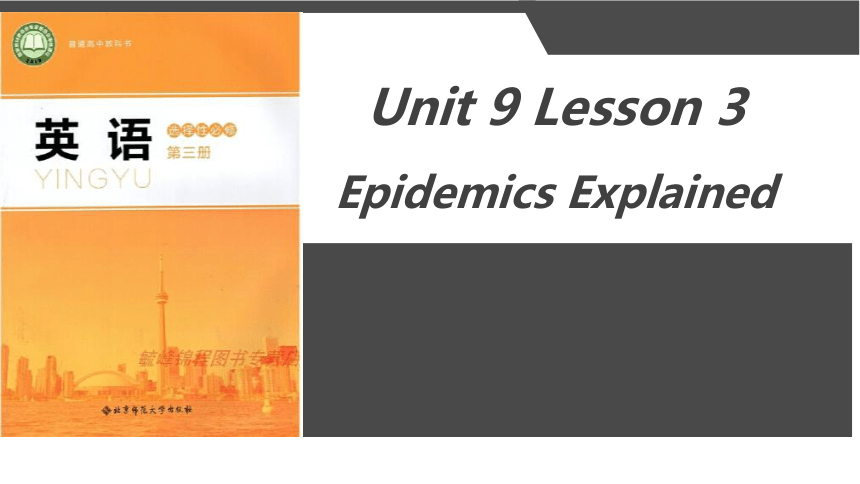 | |
| 格式 | pptx | ||
| 文件大小 | 2.9MB | ||
| 资源类型 | 教案 | ||
| 版本资源 | 北师大版(2019) | ||
| 科目 | 英语 | ||
| 更新时间 | 2024-06-27 11:01:44 | ||
图片预览

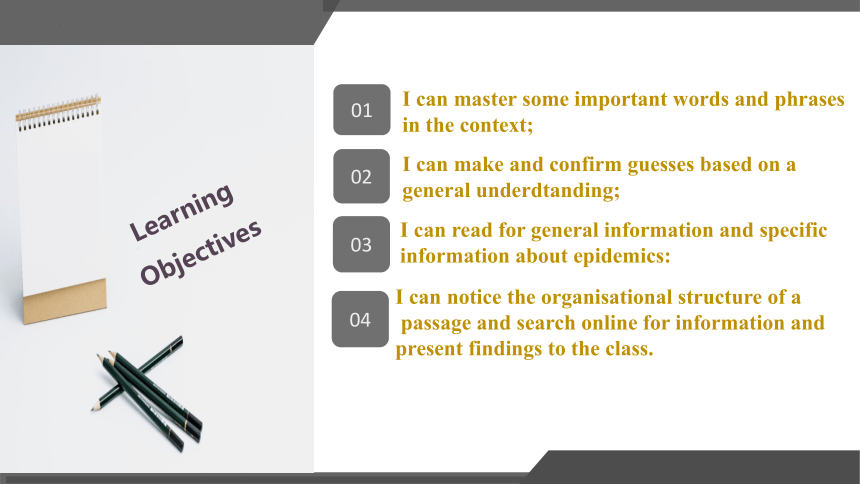

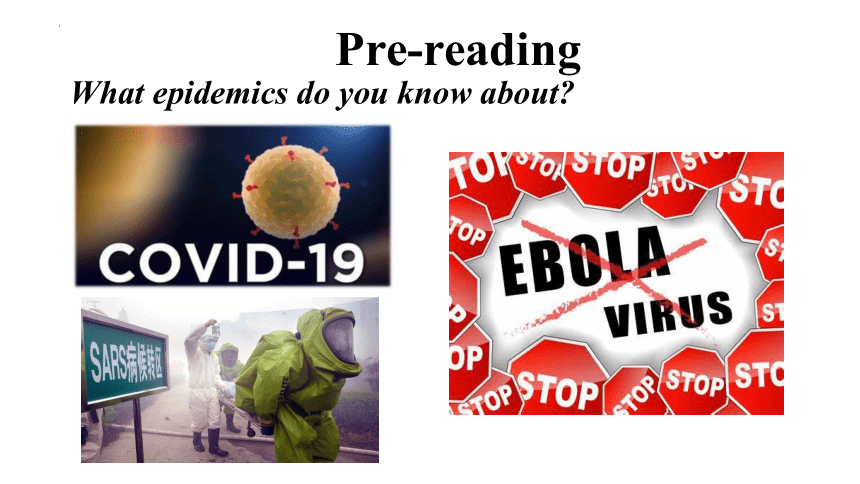
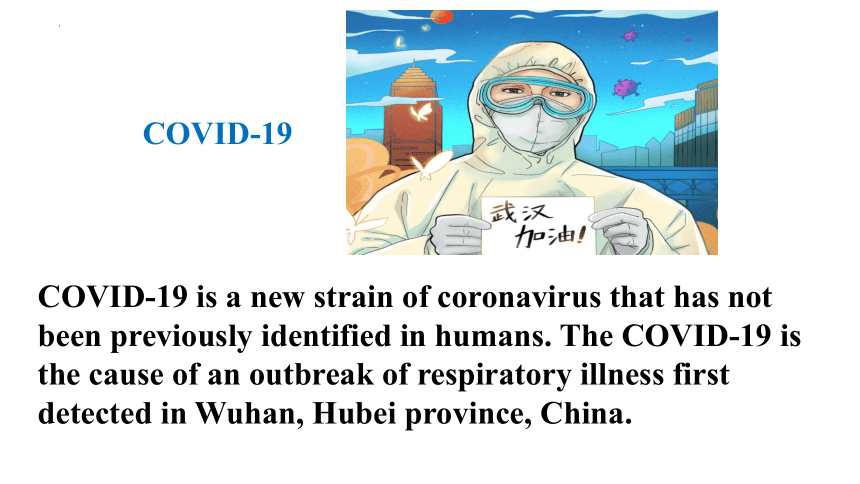
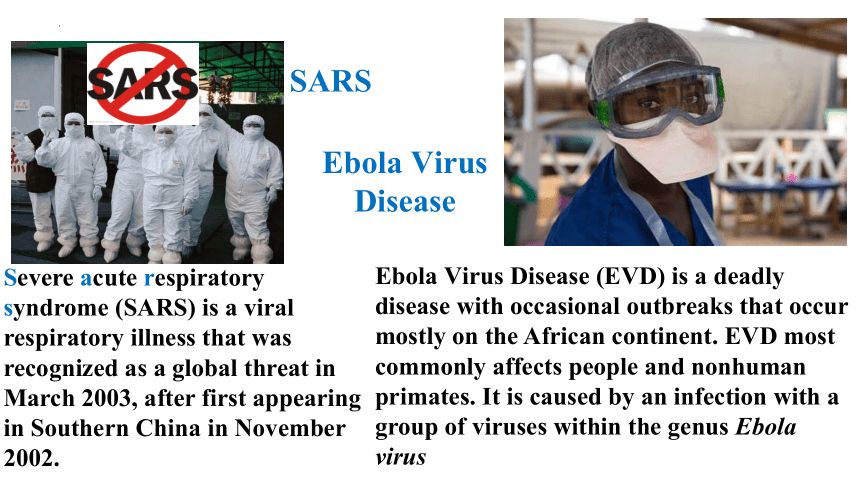
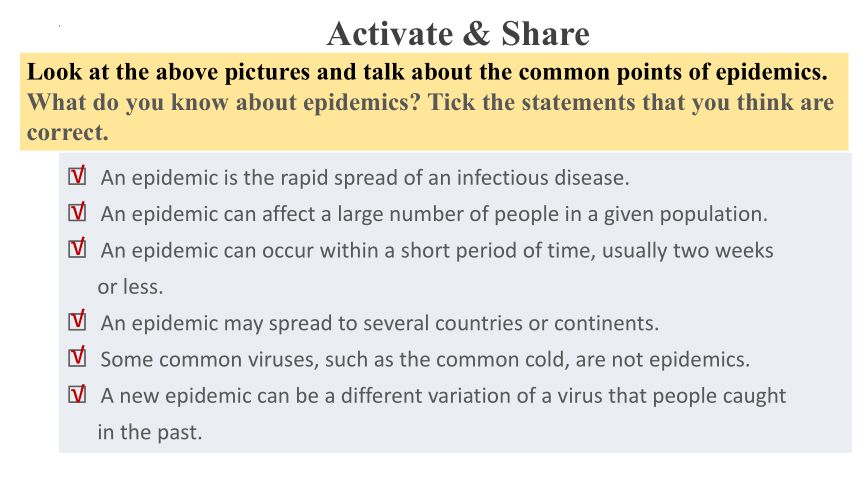

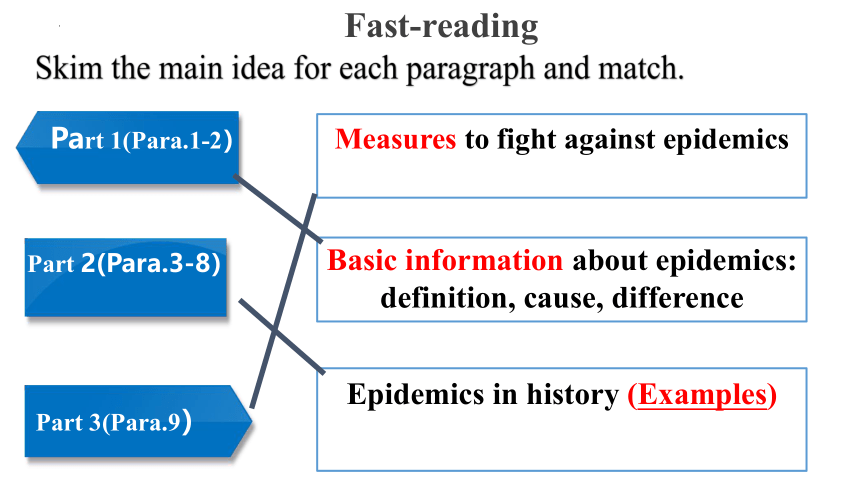
文档简介
(共21张PPT)
Unit 9 Lesson 3
Epidemics Explained
Learning
Objectives
01
02
03
I can master some important words and phrases in the context;
I can make and confirm guesses based on a general underdtanding;
I can read for general information and specific information about epidemics:
04
I can notice the organisational structure of a
passage and search online for information and present findings to the class.
Do you know the following words and phrases after the preview
1.在短时间内____________ 2. 和...接触___________
3.将...分类_________________ 4. 一定数量的________________
5. 与sth相反____________ 6. 创造一个更美好的未来________________
7. 详细叙述__________ 8. 有记载/记录的 ___________
9. 度过/熬过困难时期___ 10.构成威胁_____________
11. 感染率 _________ 12.在...的过程中_____________________
13. 作为...的结果 ___________ 14.导致 ___________
15. 从...中康复过来 ____ 16. 查明/发现___________________
17. 提出/想出_________________ 18.在全球范围内_________________________
19. 媒体报道 _ 20.将…和…相提并论 __________________
within a short period of time
come into contact with
be classified as
a certain number of
as opposed to
creative a more positive future
go into detail
on record
in the course of
get through
pose a threat
infection rates
as a result of
result in
get over
get it
come up with
across the globe
press report
draw parallels between...and...
Pre-reading
What epidemics do you know about
COVID-19
COVID-19 is a new strain of coronavirus that has not been previously identified in humans. The COVID-19 is the cause of an outbreak of respiratory illness first detected in Wuhan, Hubei province, China.
SARS
Severe acute respiratory syndrome (SARS) is a viral respiratory illness that was recognized as a global threat in March 2003, after first appearing in Southern China in November 2002.
Ebola Virus Disease
Ebola Virus Disease (EVD) is a deadly disease with occasional outbreaks that occur mostly on the African continent. EVD most commonly affects people and nonhuman primates. It is caused by an infection with a group of viruses within the genus Ebola virus
□ An epidemic is the rapid spread of an infectious disease.
□ An epidemic can affect a large number of people in a given population.
□ An epidemic can occur within a short period of time, usually two weeks
or less.
□ An epidemic may spread to several countries or continents.
□ Some common viruses, such as the common cold, are not epidemics.
□ A new epidemic can be a different variation of a virus that people caught
in the past.
Look at the above pictures and talk about the common points of epidemics.
What do you know about epidemics Tick the statements that you think are correct.
√
√
√
√
√
√
Activate & Share
Reading
Read the passage quickly and answer the questions.
1. What is an epidemic
2. How can a disease be classified as an epidemic
An epidemic is the name given to an infectious disease that rapidly spreads to a large number of people within a short period of time — usually two weeks or less.
Each disease can only officially be classified as an epidemic once a certain number of deaths have occurred from the disease.
Fast-reading
Skim the main idea for each paragraph and match.
Part 1(Para.1-2)
Part 2(Para.3-8)
Part 3(Para.9)
Measures to fight against epidemics
Basic information about epidemics: definition, cause, difference
Epidemics in history (Examples)
Fast-reading
In order of time
In order of space
In order of logic
In order of place
Read the passage again and find all the epidemics mentioned in the passage.
Epidemics
1) Bird Flu (since 1997)
2) Epidemics in the Roman
Empire (500-550 CE)
3) The Black Death (1330s)
4) The Spanish Flu (near the end of World War I)
5) The SARS (2002-2003)
6) EVD (2013-2016)
How does the passage develop
Name Period Places Death toll
Bird Flu ×
Epidemics in the Roman Empire
The Black Death ×
The Spanish Flu ×
SARS ×
EVD
Read the passage carefully. Complete the table about the epidemics mentioned. Then choose one disease to talk about with a partner.
since 1997
more than a hundred lives
500 — 550 CE
Rome
half the population
1330s
Asia and Europe
1918 — the end of World War I
50 million people
2002 — 2003
China, Canada, Vietnam and Singapore
2013-2016
West Africa
more than 11310 death
Developing Concepts Based on the Text
Concepts are not always clearly defined in a text. You need to read and develop your understanding.
Read the text to get the general idea.
Identify all the information related to the concept, e.g. examples, developments, effects, etc.
Organise the information and explain the concept from different angles.
Read and understand the content in the Skill Builder.
Post-reading
□ when epidemics started
□ examples of epidemics
□ treatments
□ baseline number of deaths of epidemics
□ definition
□ when it ended
□ possible causes of epidemics
□ possible solutions
Tick the aspects of information that are mentioned in the passage.
√
√
√
√
√
Post-reading
Epidemics
definition of epidemics
baseline number of deaths of epidemics
examples of epidemics
when epidemics started
when it ended
work together to fight epidemics
Use a diagram to demonstrate in a logical way how the aspects of information are organised.
Post-reading
Post-reading
What are the main features of an epidemic Give at least two examples to illustrate your points.
What should different countries do to prevent outbreak of epidemics in the future Why
Who do you think the passage is written for
What does the title mean to you What does the writer want to convey in the passage
Work in groups and discuss the questions.
Post-reading
What are the main features of an epidemic Give at least two examples to illustrate your points.
Post-reading
They should work together because teamwork among nations across the globe can save lives. This is a good example of building a community with shared future for mankind.
2 What should different countries do to prevent outbreak of epidemics in the future Why
Post-reading
3 Who do you think the passage is written for
This is a popular science article. It is more likely to be written for people who is interested in this topic or who has a lot of questions or misunderstanding of epidemics.
◆ The title means that the passage will explain questions about
epidemics.
◆ The author wants to convey the information that we are always
on our way to find an explanation to epidemics so as to find
cure. It also implies that epidemics occurred naturally and
inevitably(不可避免地). We can only explain it, and cannot
prevent it or stop it completely now.
4 What does the title mean to you What does the writer want to convey in the passage
Post-reading
Epidemics can be caused by …
Diseases can only be officially classified as epidemics when …
The Spanish Flu spread worldwide because …
Since the end of the SARS epidemic, scientists …
Countries need to work together to conduct thorough and systematic research because …
Complete these sentences in your own words.
Post-reading
Epidemics can be caused by a virus being carried into an area, or changes in the way people live.
Diseases can only be officially classified as epidemics when a baseline number of people have died from the disease.
The Spanish Flu spread worldwide because soldiers and other people were moving and travelling around the world after World War I.
Since the end of the SARS epidemic, scientists have been doing experiments on treatments to prevent further outbreaks.
Countries need to work together to conduct thorough and systematic research because teamwork among nations across the globe can save lives.
Search online in groups and find some information about epidemics in China or Asia. Report your information to the class.
Assignment
COVID-19 is a new strain of coronavirus that has not been previously identified in humans. The COVID-19 is the cause of an outbreak of respiratory illness first detected in Wuhan, Hubei province, China. Since December 2019, cases have been identified in a growing number of countries. And the number continues to increase ...
Unit 9 Lesson 3
Epidemics Explained
Learning
Objectives
01
02
03
I can master some important words and phrases in the context;
I can make and confirm guesses based on a general underdtanding;
I can read for general information and specific information about epidemics:
04
I can notice the organisational structure of a
passage and search online for information and present findings to the class.
Do you know the following words and phrases after the preview
1.在短时间内____________ 2. 和...接触___________
3.将...分类_________________ 4. 一定数量的________________
5. 与sth相反____________ 6. 创造一个更美好的未来________________
7. 详细叙述__________ 8. 有记载/记录的 ___________
9. 度过/熬过困难时期___ 10.构成威胁_____________
11. 感染率 _________ 12.在...的过程中_____________________
13. 作为...的结果 ___________ 14.导致 ___________
15. 从...中康复过来 ____ 16. 查明/发现___________________
17. 提出/想出_________________ 18.在全球范围内_________________________
19. 媒体报道 _ 20.将…和…相提并论 __________________
within a short period of time
come into contact with
be classified as
a certain number of
as opposed to
creative a more positive future
go into detail
on record
in the course of
get through
pose a threat
infection rates
as a result of
result in
get over
get it
come up with
across the globe
press report
draw parallels between...and...
Pre-reading
What epidemics do you know about
COVID-19
COVID-19 is a new strain of coronavirus that has not been previously identified in humans. The COVID-19 is the cause of an outbreak of respiratory illness first detected in Wuhan, Hubei province, China.
SARS
Severe acute respiratory syndrome (SARS) is a viral respiratory illness that was recognized as a global threat in March 2003, after first appearing in Southern China in November 2002.
Ebola Virus Disease
Ebola Virus Disease (EVD) is a deadly disease with occasional outbreaks that occur mostly on the African continent. EVD most commonly affects people and nonhuman primates. It is caused by an infection with a group of viruses within the genus Ebola virus
□ An epidemic is the rapid spread of an infectious disease.
□ An epidemic can affect a large number of people in a given population.
□ An epidemic can occur within a short period of time, usually two weeks
or less.
□ An epidemic may spread to several countries or continents.
□ Some common viruses, such as the common cold, are not epidemics.
□ A new epidemic can be a different variation of a virus that people caught
in the past.
Look at the above pictures and talk about the common points of epidemics.
What do you know about epidemics Tick the statements that you think are correct.
√
√
√
√
√
√
Activate & Share
Reading
Read the passage quickly and answer the questions.
1. What is an epidemic
2. How can a disease be classified as an epidemic
An epidemic is the name given to an infectious disease that rapidly spreads to a large number of people within a short period of time — usually two weeks or less.
Each disease can only officially be classified as an epidemic once a certain number of deaths have occurred from the disease.
Fast-reading
Skim the main idea for each paragraph and match.
Part 1(Para.1-2)
Part 2(Para.3-8)
Part 3(Para.9)
Measures to fight against epidemics
Basic information about epidemics: definition, cause, difference
Epidemics in history (Examples)
Fast-reading
In order of time
In order of space
In order of logic
In order of place
Read the passage again and find all the epidemics mentioned in the passage.
Epidemics
1) Bird Flu (since 1997)
2) Epidemics in the Roman
Empire (500-550 CE)
3) The Black Death (1330s)
4) The Spanish Flu (near the end of World War I)
5) The SARS (2002-2003)
6) EVD (2013-2016)
How does the passage develop
Name Period Places Death toll
Bird Flu ×
Epidemics in the Roman Empire
The Black Death ×
The Spanish Flu ×
SARS ×
EVD
Read the passage carefully. Complete the table about the epidemics mentioned. Then choose one disease to talk about with a partner.
since 1997
more than a hundred lives
500 — 550 CE
Rome
half the population
1330s
Asia and Europe
1918 — the end of World War I
50 million people
2002 — 2003
China, Canada, Vietnam and Singapore
2013-2016
West Africa
more than 11310 death
Developing Concepts Based on the Text
Concepts are not always clearly defined in a text. You need to read and develop your understanding.
Read the text to get the general idea.
Identify all the information related to the concept, e.g. examples, developments, effects, etc.
Organise the information and explain the concept from different angles.
Read and understand the content in the Skill Builder.
Post-reading
□ when epidemics started
□ examples of epidemics
□ treatments
□ baseline number of deaths of epidemics
□ definition
□ when it ended
□ possible causes of epidemics
□ possible solutions
Tick the aspects of information that are mentioned in the passage.
√
√
√
√
√
Post-reading
Epidemics
definition of epidemics
baseline number of deaths of epidemics
examples of epidemics
when epidemics started
when it ended
work together to fight epidemics
Use a diagram to demonstrate in a logical way how the aspects of information are organised.
Post-reading
Post-reading
What are the main features of an epidemic Give at least two examples to illustrate your points.
What should different countries do to prevent outbreak of epidemics in the future Why
Who do you think the passage is written for
What does the title mean to you What does the writer want to convey in the passage
Work in groups and discuss the questions.
Post-reading
What are the main features of an epidemic Give at least two examples to illustrate your points.
Post-reading
They should work together because teamwork among nations across the globe can save lives. This is a good example of building a community with shared future for mankind.
2 What should different countries do to prevent outbreak of epidemics in the future Why
Post-reading
3 Who do you think the passage is written for
This is a popular science article. It is more likely to be written for people who is interested in this topic or who has a lot of questions or misunderstanding of epidemics.
◆ The title means that the passage will explain questions about
epidemics.
◆ The author wants to convey the information that we are always
on our way to find an explanation to epidemics so as to find
cure. It also implies that epidemics occurred naturally and
inevitably(不可避免地). We can only explain it, and cannot
prevent it or stop it completely now.
4 What does the title mean to you What does the writer want to convey in the passage
Post-reading
Epidemics can be caused by …
Diseases can only be officially classified as epidemics when …
The Spanish Flu spread worldwide because …
Since the end of the SARS epidemic, scientists …
Countries need to work together to conduct thorough and systematic research because …
Complete these sentences in your own words.
Post-reading
Epidemics can be caused by a virus being carried into an area, or changes in the way people live.
Diseases can only be officially classified as epidemics when a baseline number of people have died from the disease.
The Spanish Flu spread worldwide because soldiers and other people were moving and travelling around the world after World War I.
Since the end of the SARS epidemic, scientists have been doing experiments on treatments to prevent further outbreaks.
Countries need to work together to conduct thorough and systematic research because teamwork among nations across the globe can save lives.
Search online in groups and find some information about epidemics in China or Asia. Report your information to the class.
Assignment
COVID-19 is a new strain of coronavirus that has not been previously identified in humans. The COVID-19 is the cause of an outbreak of respiratory illness first detected in Wuhan, Hubei province, China. Since December 2019, cases have been identified in a growing number of countries. And the number continues to increase ...
